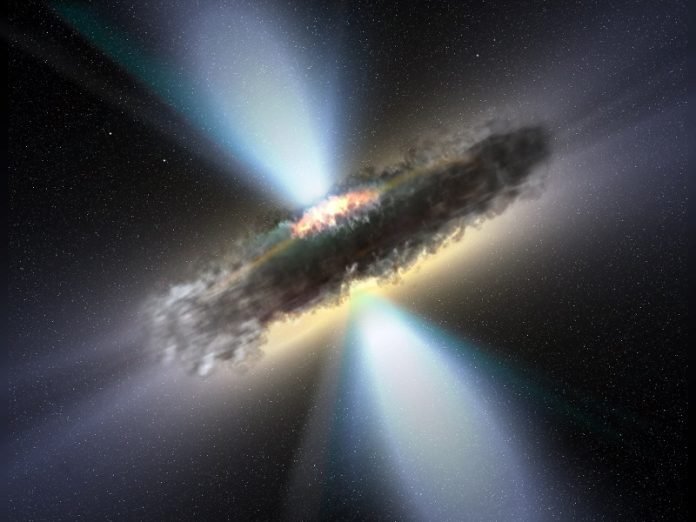
Have you ever played hide and seek?
Imagine if the entire room you were in was stuffed with fluffy pillows, making it extra tough to find someone.
Scientists have found that some of the universe’s biggest and brightest cosmic players – quasars – love playing this game, and they’re pretty good at hiding!
Quasars are not your average celestial bodies. They’re super bright, like massive cosmic lighthouses, and they’re powered by giant black holes that munch on gas and dust.
But sometimes, we can’t see these brilliant beacons because they’re hiding behind clouds.
For the longest time, astronomers thought that quasars were only hidden when there was a doughnut-shaped cloud of dust swirling right next to the black hole, like a thick fog on a dark night.
But now, thanks to some clever detective work using a powerful telescope in Chile called ALMA, a group of scientists from Durham University has uncovered a new twist in our cosmic game of hide and seek.
They’ve found out that it’s not just the close-by doughnut dust that’s doing the hiding.
Sometimes, the entire galaxy where the quasar lives acts like a huge blanket, wrapping the quasar up so tightly that even X-rays can’t get out. Imagine a thick fog covering an entire city, hiding it from view – it’s something like that.
These researchers looked at galaxies that are making stars faster than a baker makes donuts. These are called “starburst galaxies,” and they’re tiny but mighty, only about 3000 light-years across.
To give you an idea, our Milky Way is over 100,000 light-years wide! Even though they’re small, starburst galaxies are busy places where stars are popping up faster than popcorn, with over 1000 sun-sized stars being born every year.
To make all these stars, these galaxies need lots of ingredients, like gas and dust. All this material gets whipped up and swirled around by the frantic pace of star-making.
It can pile up in such massive amounts that it can completely hide a quasar sitting in the middle of the galaxy.
This is pretty big news because it changes how we think about where to look for quasars. It’s like realizing that the person you’re seeking in hide and seek could be under a pile of laundry and not just behind the curtain.
The team from Durham University thinks that about 10 to 30 percent of these super star-making quasars are playing this extreme version of cosmic hide and seek, where the galaxy itself is their hiding spot.
What’s really exciting is that finding these hidden quasars gives us clues about how galaxies grow up and how their central black holes get so big. It seems that when a galaxy is young and stuffed with cold gas and dust, it’s the perfect time for both the galaxy and the black hole at its heart to grow.
Professor David Alexander, one of the scientists in the team, described it as a “cosmic food fight.” There’s so much action with gas and stars all over the place in the galaxy’s center that it ends up hiding the baby quasar inside a cozy cocoon of dust.
So, uncovering these sneaky quasars is like finding the hidden treasures of the universe. It helps us understand the mysterious link between the giant black holes and the galaxies they live in.
And just like finding someone in hide and seek, finding these quasars gives us the joy of discovery and learning more about the cosmic game we’re all a part of.
Follow us on Twitter for more articles about this topic.



